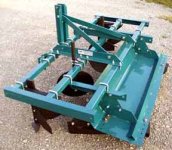My main garden was 83' x 103' and I used a walk behind tiller until I got a tractor and tiller. And I used the same one row planter that Dumbdog provided a link to; bought it at Gebo's before we got a Tractor Supply Co. store in our area, but the price was the same. I did spend a little more because I ordered all the "optional" seed plates to go with it. And maybe I spent a little more time than necessary laying out the rows because I drove steel rods into the ground at each end of each row. Then I pulled a string from rod to rod to lay out the rows. I had a long enough string to do 4 rows at at time. Some things were single rows; just push the planter down one side of the string, and some were double rows, push the planter down on side of the string and back up the other side. The planter has a little chain that's supposed to pull the dirt back over the seeds, and in my opinion it wasn't quite heavy enough, so I usually walked back down the rows dragging a garden rake over them to pull the dirt over the seed a little better. The back wheel on the planter is also supposed to "pack" the dirt down on the seeds, but I never worried about that because as soon as I put the seeds in the ground, I just used water to settle the dirt on the seeds.

